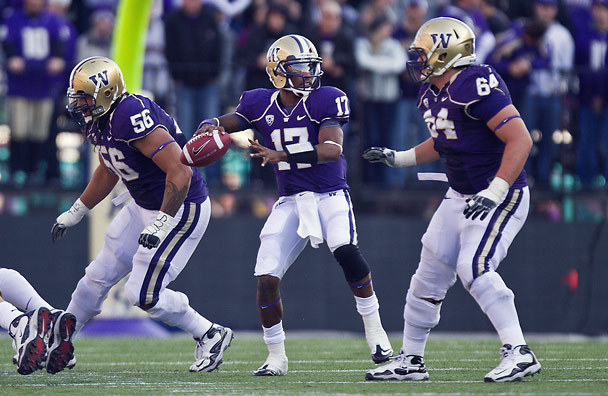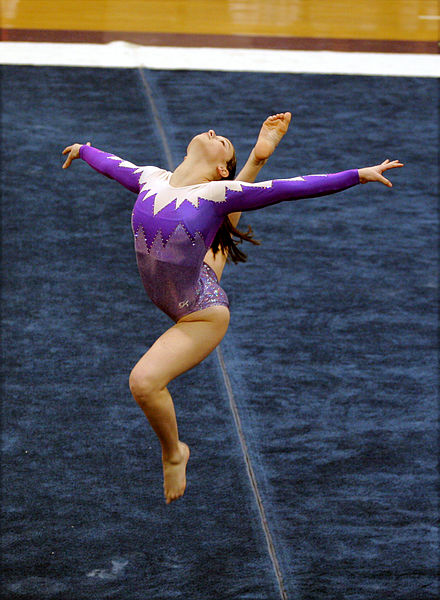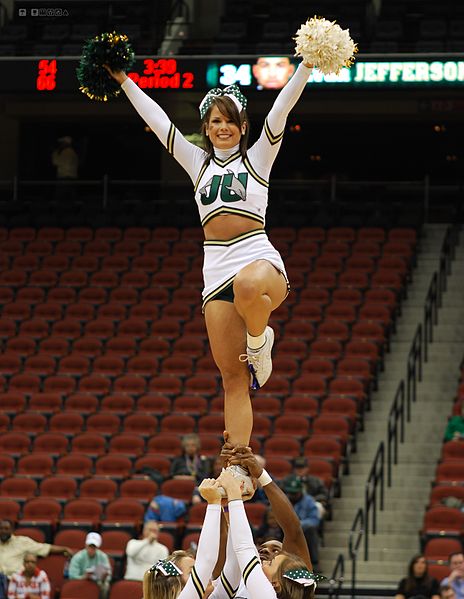With the start of a new school year it's a good opportunity to remind anyone thinking about participating in sports of some simple things you can do to prevent some common injuries. Check back regularly, we will be adding new sports regularly!
- Football (American)
Gymnastics
Cheerleading
Football (American)
 Football (American) is one of the most watched and played sports played by athletes of all ages. According to the U.S. Consumer Product Safety Commission more than 920,000 under the age of 18 were treated in medical clinics for football related injuries, most of which could have been prevented.
Football (American) is one of the most watched and played sports played by athletes of all ages. According to the U.S. Consumer Product Safety Commission more than 920,000 under the age of 18 were treated in medical clinics for football related injuries, most of which could have been prevented.
Some of the most common football injuries include:
Overuse Injuries - Lower back or overall back pain is a common complaint in Football (American) players due to overuse. Often a leading cause is overtraining syndrome. This is when a player trains beyond the ability for the body to easily recover. Knee pain is another problem that football players complain of, this can usually be dealt with by a quadriceps-strengthening program.
Concussions - One of the most common injuries in Football (American). A concussion occurs due to a traumatic impact. Some signs of concussion are; headache, dizziness, nausea, drowsiness, loss of balance, numbness, burry vision, and difficulty concentrating. Concussions can be a very serious injury, if you think you may have suffered from one seek medical care immediately.
Heat Injuries - With the start of training camp this is a large concern. Most often occurs with the intense physical activities associated with long outdoor training sessions in the height of summer. Sweating depletes the body of salt and water. Some of the symptoms you may note are cramping, if not treated with simple body cooling and fluids you can suffer from heat stroke or heat exhaustion which can if untreated lead to death.
Traumatic Injuries - Knee injuries in football are the most common, especially those to the anterior or posterior cruciate ligament (ACL/PCL) and to the menisci (cartilage of the knee). These knee injuries can adversely affect a player's longterm involvement in the sport. Football players also have a higher chance of ankle sprains due to the surfaces played on and cutting motions. Shoulder injuries are also quite common and the labrum (cartilage bumper surrounding the socket part of the shoulder) is particularly susceptible to injury, especially in offensive and defensive linemen. In addition, injuries to the acromioclavicular joint (ACJ) or shoulder are seen in football players.
Football Injury Prevention Tips
- Perform proper warm-up and cool-down routines
- Consistently incorporate strength training and stretching
- Hydrate adequately to maintain health and minimize cramps
- Stay active during summer break to prepare for return to sports in the fall
- Wear properly fitted protective equipment, such as a helmet, pads, and mouth guard
- Tackle with the head up and do not lead with the helmet
- Have a pre-season health and wellness evaluation
- Speak with a sports medicine professional or athletic trainer if you have any concerns about football injuries or football injury prevention strategies
Gymnastics
 Gymnasts must consistently prepare for the rigorous physical and emotional toils that the sport requires. With the complexity of routines, the risk of potential injury increases. Injuries most commonly occur in the ankles, feet, lower back, knees, wrists, and hands, often from overuse or simple stress. Injuries are rarely severe, but if left untreated they can lead to chronic pain and bone fractures. Each year, more than 86,000 gymnastics-related injuries are treated in hospitals, doctors' offices, clinics, and ambulatory surgery centers.
Gymnasts must consistently prepare for the rigorous physical and emotional toils that the sport requires. With the complexity of routines, the risk of potential injury increases. Injuries most commonly occur in the ankles, feet, lower back, knees, wrists, and hands, often from overuse or simple stress. Injuries are rarely severe, but if left untreated they can lead to chronic pain and bone fractures. Each year, more than 86,000 gymnastics-related injuries are treated in hospitals, doctors' offices, clinics, and ambulatory surgery centers.
Some of the most common gymnastics injuries include:
Often the upper body is used as a weight-bearing joint in gymnastics, injuries to the shoulder, elbow, and wrist are common and may include: Superior Labrum, Anterior-Posterior (SLAP) Lesions in the Shoulder, Elbow Dislocation and Wrist Sprains. The most common gymnastics injuries to the lower body involve the knee and ankle. Lower extremity injuries usually result from the landing and dismount activities and may include: Anterior Cruciate Ligament (ACL) Injury, Achilles Tendon Injury, and Lower Back Injuries.
Labral tears - (sometimes called SLAP tears) may occur during any gymnastic exercise, but ring and bar specialists seem particularly vulnerable. It is characterized by pain that initially resolves but tends to recur with return to sport. An MRI can be helpful in establishing a definitive diagnosis.
Wrist Injuries - The wrist is subjected to forces that can exceed twice the body weight. The first step in treating wrist pain is to reduce the training volume of the athlete, relieve symptoms, and to participate in only pain-free activities. After an injury, gymnasts should avoid extensive pressure on the wrist joint for six weeks. If the gymnast is experiencing pain with non-gymnastic activities of daily living, using a brace or cast to immobilize the wrist temporarily may be helpful.
ACL injuries - can result when a gymnast lands "short" or is over-rotated while tumbling, dismounting, or vaulting. A "pop" may be heard or felt followed by knee swelling with hours. MRI is often used to confirm ACL injury. As with other sports, ACL reconstruction is recommended for gymnasts who wish to return to full sports participation.
Achilies Tendons - Gymnasts can suffer from a variety of injuries to the Achilles tendon located just above the back of the heel, as a result of the repetitive stress of jumping and landing. Achilles tendinitis results in calf soreness that is aggravated with jumping and landing. Treatment should initially consist of ultrasound, stretching, activity modification, and calf exercises. Foot immobilization for seven to ten days may be beneficial for severe symptoms.
Foot & Ankle - Injuries to the foot and ankle are common in gymnastics. Acute injuries are usually sprains which can be minor or more serious. Swelling, bruising and tenderness directly over the bones are signs of a more serious injury. Minor injuries typically have tenderness limited to one side of the joint without significant swelling. Serious injuries require evaluation by a qualified professional while return to participation after a minor injury is often possible within a week if there is no pain (or limping) with weight bearing activity. Protection with taping or a brace can aid recovery and reduce the risk for re-injury. Chronic ankle pain or repeated injuries are worrisome and require evaluation before continuing with participation.
Muscle Strain - The cause of low-back pain can include muscle strain, ligament sprain, fracture, and/or disc disorders. Frequently, low-back pain will worsen with activity, especially with extension movements, such as arching the shoulders backwards. Low-back pain in gymnasts related to muscular strain or ligament sprain usually responds to rest and physical therapy exercises. Persistent back pain is uncommon and should not be ignored. An MRI or a bone scan are often helpful to rule out more significant injuries.
Gymnastics Injury Prevention Tips:
- Insist on spotters when learning new skills
- Warm up muscles with light aerobic exercise, such as jumping jacks or running in place, before beginning training or new activities
- Inspect equipment to ensure that it is in good condition, including padded floors, secured mats under every apparatus, and safety harnesses for learning difficult moves
- Wear all required safety gear whenever competing or training — special equipment may include wrist guards, hand grips, footwear, ankle or elbow braces, and pads
- Do not "play through the pain" — if you are hurt, see your doctor and follow instructions for treatment and recovery fully
- Make sure first aid is available at all competitions and practices
Cheerleading
 Cheerleading is considered an athletic activity that incorporates elements of dance and gymnastics along with stunts and pyramid formations. Cheerleading competitions at the high school and collegiate levels have created a whole new dynamic, including increased risk for injury.
Cheerleading is considered an athletic activity that incorporates elements of dance and gymnastics along with stunts and pyramid formations. Cheerleading competitions at the high school and collegiate levels have created a whole new dynamic, including increased risk for injury.
Some of the most common cheerleading injuries include:
One study estimates that cheerleading led to 28,000 emergency room visits in 2009 (the latest year for data). While not as frequent as injuries in other sports, cheerleading injuries tend to be more severe, making up more than half of the catastrophic injuries in female athletes. Cheerleading injuries affect all areas of the body — most commonly the wrists, shoulders, ankles, head, and neck.
Cheerleading Injury Prevention Tips:
Stunt restrictions - In an attempt to curb the amount of catastrophic injuries in cheerleading, restrictions have been placed on stunts. They range from height restrictions in human pyramids, to the thrower-flyer ratio, to the number of spotters that must be present for each person lifted above shoulder level.
For example, the limit for pyramids is two body lengths for the high school level and 2.5 body lengths for the college level, with the base cheerleader in direct contact with the performing surface. Base supporters must remain stationary and the suspended person is not allowed to be inverted or rotate on dismount.
Basket toss stunts in which a cheerleader is thrown into the air (sometimes as high as 20 feet) are only allowed to have four throwers. The person being tossed (flyer) is not allowed to drop the head below a horizontal plane with the torso. One of the throwers must remain behind the flyer at all times during the toss.
Mats should be used during practice sessions and as much as possible during competitions. Cheerleaders should not attempt a stunt if they are tired, injured, or ill, as this may disrupt their focus and cause the stunt to be performed in an unsafe manner.
Training - The importance of a qualified coach is also critical. Coaching certification is encouraged. Precautions should always be taken during inclement weather for all stunts. Also, a stunt should not be attempted without proper training, and not until the cheerleader is confident and comfortable with performing the stunt. Supervision should be provided at all times during stunt routines.
As with any sport, proper conditioning and training are important to minimize injury, including:
- Resistance exercises to gain strength in the lower back, stomach, and shoulders
- Regular stretching, yoga, or pilates instruction to improve flexibility
- Speaking with a sports medicine professional or athletic trainer if you have any concerns about injuries or cheerleading injury prevention strategies
- Returning to play only when clearance is granted by a healthcare professional